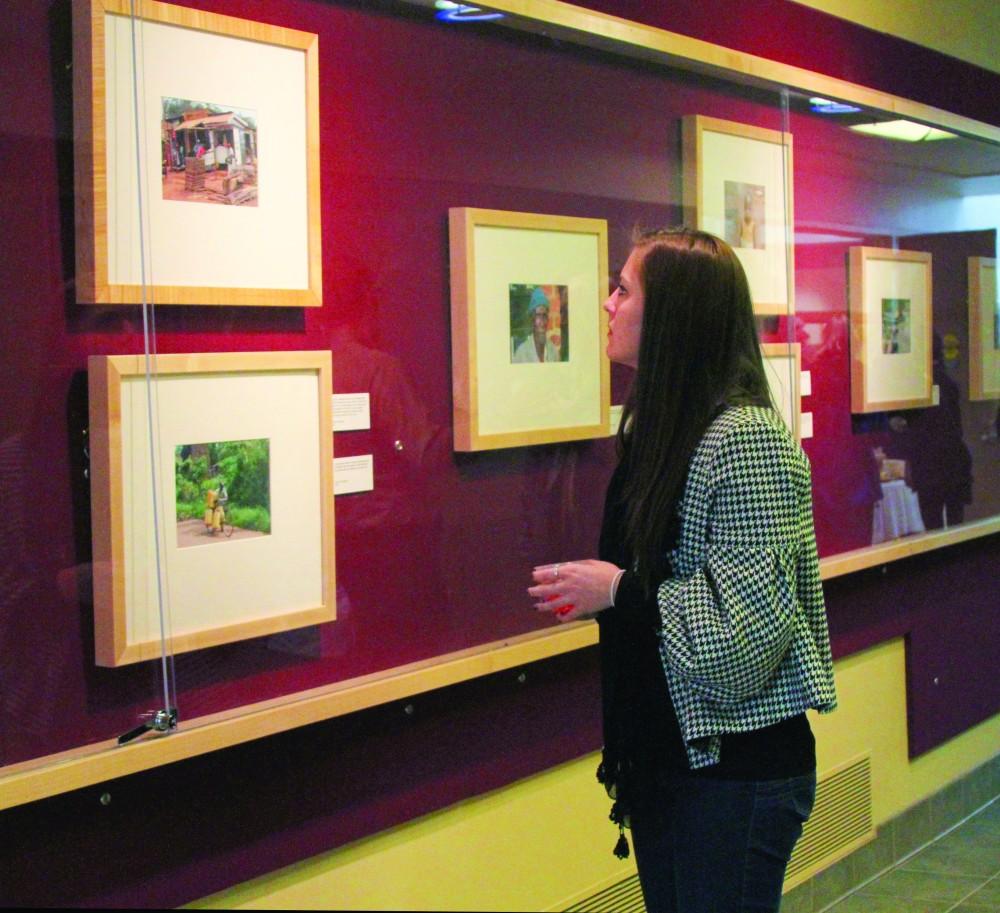Shining positive light on Uganda

GVL / Emma Moulton Kaylie Miller views the Life in Uganda exhibit at the Red Wall Gallery
Jan 9, 2013
Ken VanderWal is a boiler engineer who controls the temperature throughout the Grand Valley State University Allendale Campus, but he has a passion for traveling to different countries.
And now he’s behind the newest exhibition in Lake Ontario Hall’s Red Wall Gallery, “Mukono to Kampala: Life in Uganda.” The exhibit is a collection of photographs VanderWal took during 13 mission trips he took to Uganda starting in August 2004.
Henry Matthews, director of galleries and collections, wants students to see things from around the world in the galleries around campus.
“When I view these photographs it always makes me want to go and participate in the activities, see the sights, meet the people, smell and taste everything of the region,” Matthews said.
Matthews said once the exhibit has finished, the photographs will be scattered around campus to spark the interest of students who want to visit Uganda or other countries like it.
During a Jan. 8 reception for the gallery, Meaghann Myers-Smith, a study abroad adviser at GVSU, said there is a study abroad program in Uganda within the School of International Training.
“We have had a few students participate in a program that focuses on post-conflict studies,” Myers-Smith said. “I do think that these sorts of things around campus help to inspire that thought and eventually bring people to our office.”
While Uganda is often depicted as a poor country, VanderWal tried to photograph the positivity he saw in the native people. The gallery features photographs of Ugandan people with expressions of hope on their faces and includes scenes of daily life, as well as the common disease of malaria that is spread throughout the country.
“They show people in different stages of life: young, older, healthy and in sick,” VanderWal said. “But what I feel with these people is they have a hope, they are not depressed, they are not down-ridden, they have, I want to say, next to nothing. I’ve been in their houses where they are 10-foot square, they have no kitchen, no bathroom in their house, so strictly half of it’s a bed, half of it’s a living area, yet they have a hope, a hope where they want something better than life. They will take care of what they have to send their kids to school if at all possible, because they know an education is very important for the future.”
VanderWal said his trips to Uganda were sparked by the pastor at his church and by Hope College students from Uganda. After meeting the college students, VanderWal said they wanted him to come and see their home country.
“And really what I started doing from the beginning was going to schools, this is anywhere from elementary to high school to colleges and I’m going there to share the gospel,” VanderWal said. “I really do all speaking engagements and no physical labor as some people need to. I’m not out there building houses or none of that stuff.”
After his mission trips there, VanderWal said that he plans to move into the home that was built for him after retirement in the outskirts of Mukono. He stays there during his mission trips.
“I have almost a westernized house in the middle of Uganda,” VanderWal said. “I have a three bedroom, two bathroom ranch house with all the conveniences of home.”
He said the process for building and paying for a house in Uganda is different than normally in the United States because of the culture.
“Ugandan’s do not use banks,” he said. “Typically what they would do is work for a couple of weeks and get enough money to buy a couple bags of cement, make some bricks, and they would build as far as they could afford. They would continue after they make money. I took the Ugandan way and as I could afford it, I built it. There was never a loan on that house and so it was very convenient.”
VanderWal said he’s never felt threatened while in Uganda, but because of the culture, he’s perceived as wealthy and has to use certain security measures.
“Unfortunately what they required of me, and I hate to say this, but I have to for clarification, because we are white, we are considered wealthy and because of that, I had to add a security fence around my house,” VanderWal said.
While VanderWal captured a lot of positivity in the country, there are a large number of people who continue to die from the country’s No. 1 killer, malaria. He hopes to help prevent that by raising money to purchase and distribute mosquito nets in his neighborhood.
Paris Tennenhouse, exhibit and collections design manager at GVSU, worked with VanderWal to shrink down his photographs and prepare them for the gallery. She said that while VanderWal’s day job is a boiler engineer, he has other interests, too, and he wants to share them with the community.
The exhibition is on display until March 13. For more information on the gallery, go to www.gvsu.edu/artgallery.






















